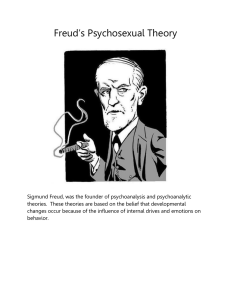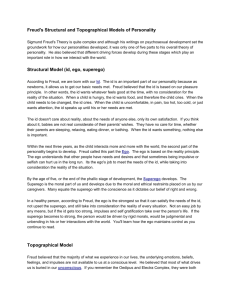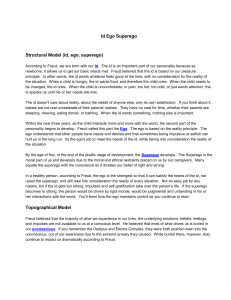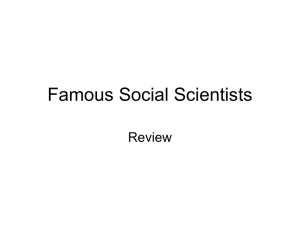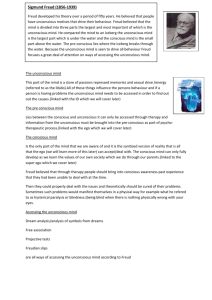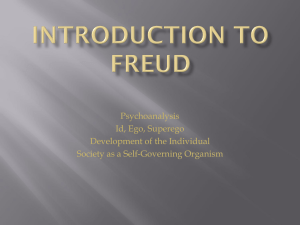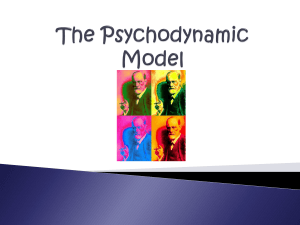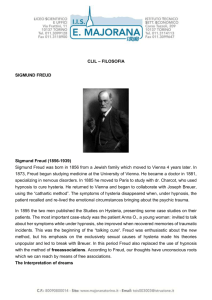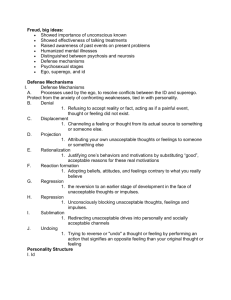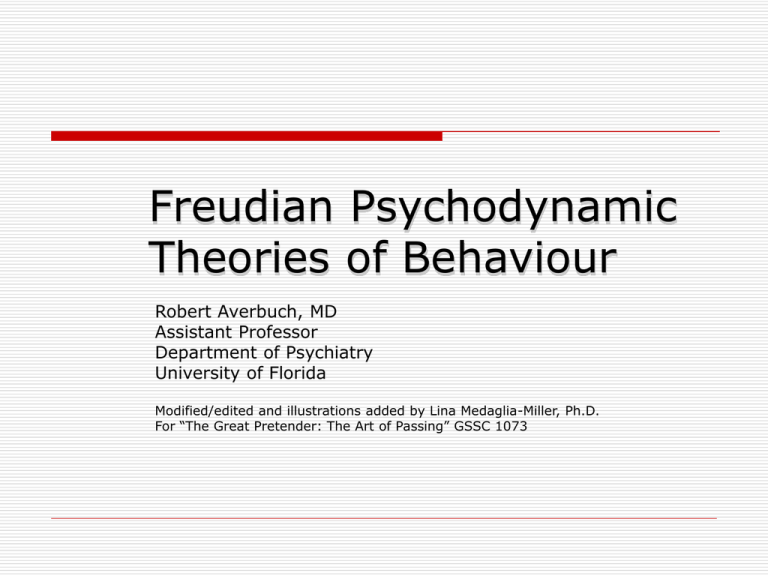
Freudian Psychodynamic
Theories of Behaviour
Robert Averbuch, MD
Assistant Professor
Department of Psychiatry
University of Florida
Modified/edited and illustrations added by Lina Medaglia-Miller, Ph.D.
For “The Great Pretender: The Art of Passing” GSSC 1073
Who Was
Freud?
Freud’s Theories, in Context
Freud was originally trained as a
Neurologist- biological approach to
illness
Treated mostly Hysteria (conversion
disorders)
Applied findings from abnormal
patients to “normal” development
Freud: A Sign of the Times?
Time period:
late 1800’s
Victorian times:
conservative, repressed
society
Prohibitions against
sex
Selected Contributions of Freud
Psychic Determinism/ Dynamic Model
The Power of Catharsis
Transference and Countertransference
Topographical Model of the Mind
Unconscious, Preconscious, Conscious
Selected Contributions of Freud
Structural Model of
the Mind
ID, EGO, SuperEGO
Defense Mechanisms
Behavior is Predetermined
Freud sees people as
passive; behaviors
determined by interaction
of external reality and family
with internal drives
Psychic Determinism:
all behaviors driven by
past experiences
“There are no accidents”
Conflict and Behavior
Instinctual Drives (libidinal:
sexual, aggressive) instincts
drive people
Behaviors result from conflicts:
Between instinctual (libidinal)
drives and efforts to repress
them from consciousness
Catharsis
Inherent benefits
come from releasing
pent-up tension
Some inherent value
in the “talking cure”:
being able to “unload,”
or “get stuff off your
mind”
Transference
and
Countertransference
Transference
Aka “emotional
baggage”
UNCONSCIOUS
misattribution of
feelings, attitudes,
and expectations
from an important
childhood relationship
to a current one
Countertransference
Traditionally refers to
the physician projecting
her own feelings
(“issues,” “emotional
baggage”) onto her
patient
The corollary to
“Transference”
Freud’s
Topographic
Model
The “Landscape”
of the Mind
Topographical Model
Freud’s first model of
psychopathology
Division of the mind into three
different layers of consciousness:
Unconscious
Preconscious
Conscious
Freud conceived of these levels as
parts of a “mental iceberg”
Unconscious
Contains repressed
thoughts and feelings
Unconscious shows
itself in:
Dreams
Hypnosis
Parapraxes (Freudian
slips)
Driven by Primary
Process Thinking
Primary Process Thinking
Not cause-effect; illogical;
fantasy
Only concern is immediate
gratification
(drive satisfaction)
Does not take reality
into account
Seen in dreams, during
hypnosis, some forms of
psychosis, young children,
psychoanalytic psychotherapy
Freudian Slips (Parapraxes)
A “slip of the tongue”
Errors of speech or hearing that
reveal one’s true but unconscious
feelings
Preconscious
Accessible, but not immediately
available
Always running in the background/
behind the scenes
Conscious
Fully and readily
accessible
Conscious mind does
not have access to the
unconscious
Utilizes Secondary
Process Thinking:
Reality-based (takes
external reality into
consideration), logical,
mature, time-oriented
Structural Theory
ID, EGO, and SuperEGO
The Structural Model
The ID
Home of
instinctual Drives
Completely
Unconscious
Present at birth
“I want it and I
want it NOW!”
(Governed by Pleasure
Principle)
The Superego
Internalized morals/
values- sense of right
and wrong
aka Conscience
Suppresses drives of ID
(thru guilt and shame)
The Superego
Mostly unconscious
Develops with socialization,
and thru identification
with same-sex parent
(Neo-Freudians
acknowledge that
identifications can be
with either parent)
The EGO
Mediates between
the Id, Superego,
and reality
Mostly conscious
Governed by
Reality Principle
Defense
Mechanisms
Keeping the
unpleasant
stuff out of mind
“Ego” Defense Mechanisms
They serve to
protect an individual’s
Ego from unpleasant
thoughts or emotions
Mostly unconscious
Mature/Healthy Defenses
Altruism
Anticipation
Humour
Sublimation
Suppression
Sublimation
Rerouting an
unacceptable drive in
a socially acceptable
(often constructive)
way
A healthy, conscious
defense
Martial arts, sports
Suppression
Deliberately
(consciously)
pushing
anxiety-provoking
material out of
conscious
awareness
Immature Defenses
Repression
Acting Out
Somatization
Regression
Denial
Projection
Splitting
Displacement
Reaction
Formation
Magical Thinking
Intellectualization
Rationalization
Repression
Keeping an idea or
feeling out of conscious
awareness
The primary ego
defense
Freud postulated that
other defenses are
employed only when
repression fails
Acting out
Behaving in an
attention-getting,
often socially
inappropriate
manner
to avoid dealing
with
unacceptable
emotions
or material
Somatization
Unacceptable impulses or feelings
converted into physical symptoms
Regression
Return to earlier
level of functioning
(childlike
behaviors)
during stressful
situations
Kids regress
after trauma
Denial
Unconsciously
discounting external
reality
Projection
Falsely attributing one’s
own unacceptable impulses
or feelings onto others
Can manifest as
paranoia
Splitting
Selectively focusing
on only part of a person
Seeing people as
either all-good or
all-bad (Black and
White thinking)
Serves to relieve the
uncertainty engendered by
the fact that people have both
bad and good qualities
Displacement
Redirection of
unacceptable feelings,
impulses from their
source onto a less
threatening person
or object
Mad at your boss,
so you go home and
kick the dog
Reaction Formation
Transforming an
unacceptable impulse
into a diametrically opposed
thought, feeling, attitude, or
behavior; denying
unacceptable feelings and
adopting opposite attitudes
Ex. Person who loves
pornography leads a
movement to outlaw
its sale in the neighborhood
Magical Thinking
The idea that one can
control external events
just by thinking a certain
way, or by doing
something
that’s unrelated
(superstitious behavior)
Intellectualization
Using higher cortical
functions to avoid
experiencing
uncomfortable
emotions; thinking
without accompanying
emotion
Rationalization
Perceived controversial
behaviors or feelings are
explained in a rational or
logical manner to avoid
the true explanation
The End / Fin


